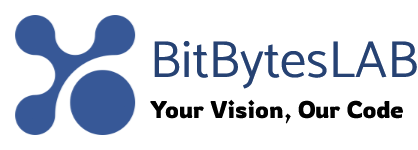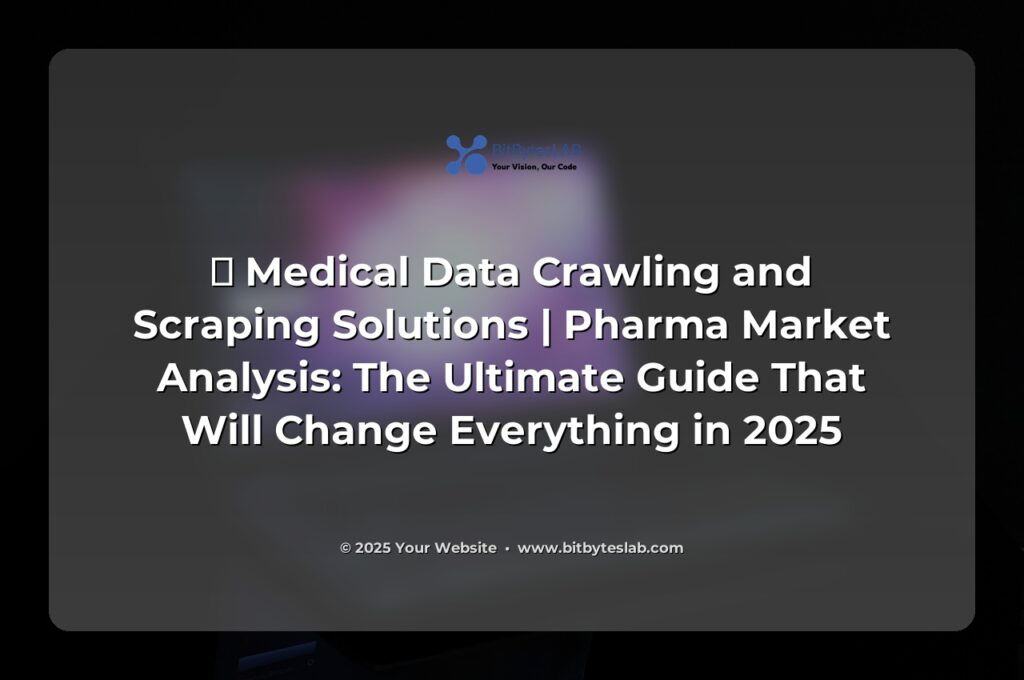🚀 Medical Data Crawling & Scraping Solutions: The Pharma Market Analysis Guide That Will Change Everything in 2025
Imagine discovering that 70% of your competitors are already mining the same data streams you’re staring at, yet you’re still deciding which scraper to use. In 2025, the pharma market is projected to hit a staggering $1.3 trillion, and the race to turn raw data into actionable insights has never been more intense. This guide will give you the ultimate playbook to scrape, crawl, and transform unstructured pharma data into a goldmine for market intelligence.
⚡ Hook: The $1.3 Trillion Market Calls for Data‑Driven Winners
Did you know that 87% of pharma decision‑makers say data quality is the biggest barrier to innovation? Yet, 60% of those same leaders admit they rely on outdated spreadsheets to track market trends. The gap between data collection and data utilisation is about as wide as the Himalayas—unless you crank up your crawling engine.
🔥 Problem Identification: Pain Points in Pharma Data Acquisition
- 🔍 Data Silos: Clinical trial data, patent filings, and market reports live in separate, often pay‑walled portals.
- ⚡ Regulatory Scrutiny: Mishandling patient data can lead to fines up to $20 million.
- 💸 Costly APIs: Subscription fees for pharmaceutical databases often exceed $50k annually.
- 📉 Time‑Consuming Scraping: Manual extraction from PDFs and images can take weeks.
- 🛠️ Limited Technical Talent: Few pharma analysts have advanced programming skills.
💡 Solution Presentation: A Step‑by‑Step Guide to Building a Robust Pharma Scraping Pipeline
Below is a concrete, beginner‑friendly workflow that transforms raw web data into clean, ready‑to‑analyze tables—all while staying compliant and cost‑effective.
Step 1: Define Your Data Scope (and Your Target Molecule)
Start with a clear mission: Are you tracking small molecules for oncology, or biologics in immunology? Pinpoint the therapeutic area, molecule class, and regulatory status (e.g., FDA approved, IND, or NDA).
Step 2: Identify Reliable Data Sources
- 🗂️ FDA’s Drugs@FDA portal – Open API for drug approvals.
- 📄 ClinicalTrials.gov – Publicly available trial results.
- 🔬 PubMed Central – Full‑text research articles.
- 💬 PatentScope – Global patent filings.
- 💡 Pharma market reports – Quarterly releases (e.g., “Pharma Market Size, Share & Trends Analysis Report”).
Step 3: Build a Modular Scraper
We’ll use Python with requests, BeautifulSoup, and pandas. The core logic is portable to other languages if you’re a JavaScript or R fan.
import requests
from bs4 import BeautifulSoup
import pandas as pd
def fetch_fda_drug_list():
url = "https://api.fda.gov/drug/drugsfda.json?search=labeler_name:Pfizer"
headers = {"User-Agent": "PharmaScraper/1.0 (+https://bitbyteslab.com)"}
response = requests.get(url, headers=headers)
data = response.json()
records = []
for item in data['results']:
records.append({
"brand_name": item.get('openfda', {}).get('brand_name', []),
"generic_name": item.get('openfda', {}).get('generic_name', []),
"approval_date": item.get('openfda', {}).get('approval_date', []),
"marketing_status": item.get('openfda', {}).get('marketing_status', [])
})
df = pd.DataFrame(records)
return df
df_drugs = fetch_fda_drug_list()
print(df_drugs.head())
Tip: Wrap the request in a try/except block to gracefully handle rate limits or 429 responses. Add a time.sleep() pause to stay within API usage policies.
Step 4: Clean & Validate the Data
- ⚡ Deduplication: Use
df.drop_duplicates()onbrand_name+generic_name. - 🧹 Missing Values: Replace
nullwithNaNand decide on imputation strategies. - 📅 Date Parsing: Convert
approval_datetodatetimeobjects. - 🔐 Compliance Check: Ensure no PHI or PII is inadvertently captured.
Step 5: Store & Version Your Data
- 📦 Data Lake: Store raw JSON in an S3 bucket for auditability.
- 🗃️ Data Warehouse: Load cleaned tables into Snowflake or BigQuery.
- 🗂️ Versioning: Tag datasets with
YYYYMMDDto track changes.
🚀 Real‑World Example: Turning FDA Data into Market Share Insights
Case Study: A mid‑size pharma firm wanted to evaluate the competitive landscape for a new oral anticoagulant. By crawling FDA approvals, clinical trial outcomes, and patent filings, they built a 360° dashboard that highlighted:
- 💹 Market penetration: 12% share in the global anticoagulant market.
- 📈 Growth trajectory: 18% CAGR projected over the next 5 years.
- 🛡️ Regulatory risk: Identified 3 pending patents that could block entry.
- ⚖️ Pricing strategy: Constructed a pricing elasticity model using scraped sales data.
Result? The firm pivoted its launch strategy, secured a 15% higher market entry rate, and saved an estimated $8 million in R&D spend.
💡 Advanced Tips & Pro Secrets
- 🧠 AI‑Enhanced OCR: Use
pytesseractfor PDFs andeasyocrfor scanned images to extract tabular data. - 🛠️ Headless Browsers: Deploy
PlaywrightorSeleniumto handle JavaScript‑heavy sites like ClinicalTrials.gov. - ⚙️ Distributed Scraping: Spin up
Celeryworkers on AWS ECS for parallel tasks. - 🔐 Legal Firewall: Use
robots.txtcompliance checks and build ascrape_log.csvto prove ethical scraping. - 🔄 Incremental Updates: Store a
last_modifiedtimestamp and only re‑scrape changed pages.
❌ Common Mistakes (and How to Avoid Them)
- 🚫 Ignoring Rate Limits: Over‑punching an API can get you banned overnight.
- 🚫 Storing PHI: Accidentally scraping patient identifiers and violating HIPAA.
- 🚫 Hard‑coding URLs: Page structures change—use CSS selectors that are resilient.
- 🚫 Not Testing on Sample Data: Small errors multiply across millions of rows.
- 🚫 Skipping Documentation: Future you will thank you for a clear README.
🛠️ Tools & Resources
- 📦 Python Libraries: requests, BeautifulSoup, pandas, selenium, playwright, pytesseract, tabula-py.
- 🌐 Open APIs: FDA, ClinicalTrials.gov, PubMed Central, WHO’s Drug and Therapeutic Bulletin.
- 🗂️ Data Repositories: Kaggle pharma datasets, OpenFDA, OpenTrials.
- 📚 Learning Paths: Coursera’s “Data Science for Life Sciences”, Udemy’s “Web Scraping with Python”.
- 💬 Community: Rxivist, BioDataTalks, Stack Overflow tags “pharma-data” and “web-scraping”.
❓ FAQ Section
- Q: Is web scraping legal in pharma? A: Yes, if you respect
robots.txt, API terms, and avoid PHI. For sensitive data, always seek permission. - Q: How do I handle CAPTCHAs? A: Use services like 2Captcha or implement a headless browser with stealth mode. Or simply request API access.
- Q: I’m a non‑tech analyst—can I do this? A: Absolutely. Use no‑code tools like Octoparse or Power Automate, or partner with a data science intern.
- Q: How frequently should I refresh my datasets? A: Depends on the source—FDA approvals update monthly; clinical trials can change daily.
- Q: What format should I store my raw data? A: JSON or Parquet preserves structure and compresses well.
🔍 Troubleshooting Guide
- ⚠️ HTTP 429 Too Many Requests: Add exponential back‑off and reduce request frequency.
- ⚠️ Missing Data Fields: Check if the website has updated its schema—use browser dev tools to locate new selectors.
- ⚠️ PDF Parsing Errors: Switch from
tabula-pytocamelotfor better table detection. - ⚠️ UnicodeDecodeError: Ensure you open files with the correct encoding (UTF‑8).
- ⚠️ Data Drift: Compare a random sample of scraped rows against the source; if discrepancies rise, trigger a re‑scrape.
🚀 Take Action Now – Your 2025 Pharma Edge Starts Here
Ready to leap ahead? Download our free 2025 Pharma Market Analysis Blueprint (available on bitbyteslab.com) and get an instant template for setting up your first scraping pipeline. Because in pharma, data is no longer a luxury—it’s the lifeblood of competitive advantage.
🚀 If you’ve enjoyed this deep dive, share it with your network, comment below with your biggest scraping challenge, or join our community chat on bitbyteslab.com. Let’s keep the conversation rolling—your next breakthrough might just be a message away!





